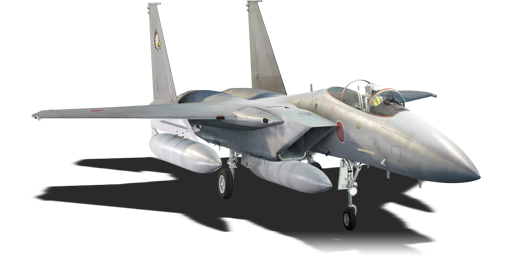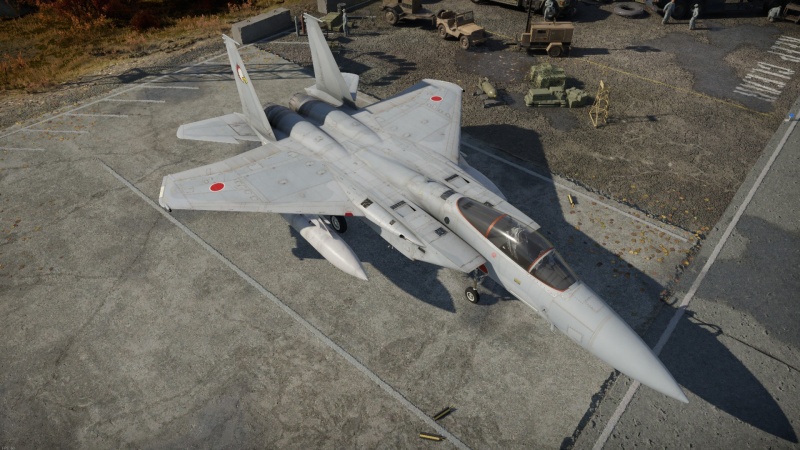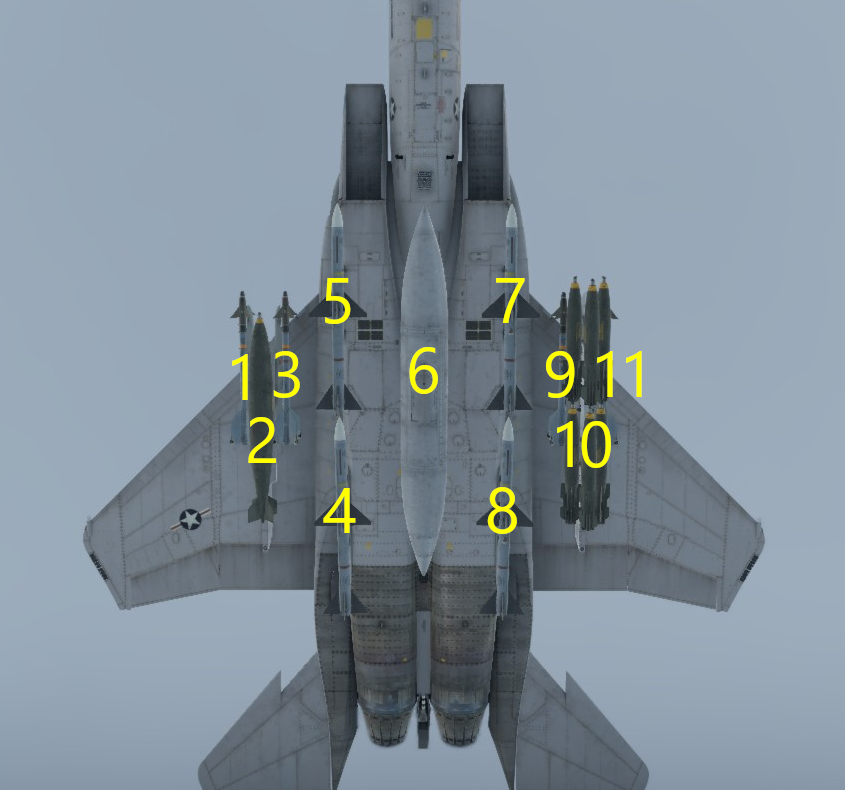F-15J
Contents
Description
The F-15J Eagle is a variant of the American F-15 Eagle customized for the Japan Air Self-Defense Force and produced under a licensing agreement with the United States, with Mitsubishi Heavy Industries taking the lead in manufacturing. The F-15J, which entered service in the early 1980s, was designed to replace Japan's ageing fleet of F-104J Eikos and F-4EJ Phantoms. This twin-engine, all-weather air superiority fighter featured advanced radar and avionics for long-range engagement. The aircraft's design emphasized air-to-air combat capabilities, featuring a mix of short and medium-range missiles, the AIM-9 Sidewinder and AIM-7 Sparrow respectively, on top of the domestic AAM-3 missile.
Introduced in Update "Air Superiority", the F-15J is the crown jewel of the Japanese air tree. This translates to a very fast dedicated air superiority fighter, that is surprisingly nimble for such a heavy machine. It remains a very capable jet even when compared to its competition like the Su-27 and the JAS39 Gripen. It is also the only plane featuring the AAM-3 domestic Japanese missile in-game.
General info
Flight performance
The F-15J is a heavy aircraft, but quite nimble for its size. It can pull surprisingly well for its weight and size. Caution should be taken between Mach 1.0 and 1.1, as a combination of elevator, rudder, and aileron deflection will easily rip the wings. It pulls very hard around 800 km/h IAS.
| Characteristics | Max speed (km/h at 10,668 m) |
Max altitude (metres) |
Turn time (seconds) |
Rate of climb (metres/second) |
Take-off run (metres) | ||||||||||||||||||||||||||||||||||||||||||||||||||||||||||||||||||||||||||||||||||||||||||||||||||||||||||||||||||||||||||||||||||||||||||||||||||||||||||||||||||||||||||||||||||||||||||||||||||||||||||||||||||||||||||||||||||||||||||||||||||||||||||||||||||||||||||||||||||||||||||||||||||||||||||||||||||||||||||||||||||||||
|---|---|---|---|---|---|---|---|---|---|---|---|---|---|---|---|---|---|---|---|---|---|---|---|---|---|---|---|---|---|---|---|---|---|---|---|---|---|---|---|---|---|---|---|---|---|---|---|---|---|---|---|---|---|---|---|---|---|---|---|---|---|---|---|---|---|---|---|---|---|---|---|---|---|---|---|---|---|---|---|---|---|---|---|---|---|---|---|---|---|---|---|---|---|---|---|---|---|---|---|---|---|---|---|---|---|---|---|---|---|---|---|---|---|---|---|---|---|---|---|---|---|---|---|---|---|---|---|---|---|---|---|---|---|---|---|---|---|---|---|---|---|---|---|---|---|---|---|---|---|---|---|---|---|---|---|---|---|---|---|---|---|---|---|---|---|---|---|---|---|---|---|---|---|---|---|---|---|---|---|---|---|---|---|---|---|---|---|---|---|---|---|---|---|---|---|---|---|---|---|---|---|---|---|---|---|---|---|---|---|---|---|---|---|---|---|---|---|---|---|---|---|---|---|---|---|---|---|---|---|---|---|---|---|---|---|---|---|---|---|---|---|---|---|---|---|---|---|---|---|---|---|---|---|---|---|---|---|---|---|---|---|---|---|---|---|---|---|---|---|---|---|---|---|---|---|---|---|---|---|---|---|---|---|---|---|---|---|---|---|---|---|---|---|---|---|---|---|---|---|---|---|---|---|---|---|---|---|---|---|---|---|---|---|---|---|---|---|---|---|---|---|---|---|---|---|---|---|---|---|---|---|
| AB | RB | AB | RB | AB | RB | ||||||||||||||||||||||||||||||||||||||||||||||||||||||||||||||||||||||||||||||||||||||||||||||||||||||||||||||||||||||||||||||||||||||||||||||||||||||||||||||||||||||||||||||||||||||||||||||||||||||||||||||||||||||||||||||||||||||||||||||||||||||||||||||||||||||||||||||||||||||||||||||||||||||||||||||||||||||||||||||||||||||
| Stock | 2,534 | 2,505 | 16764 | 22.5 | 22.7 | 262.6 | 248.2 | 750 | |||||||||||||||||||||||||||||||||||||||||||||||||||||||||||||||||||||||||||||||||||||||||||||||||||||||||||||||||||||||||||||||||||||||||||||||||||||||||||||||||||||||||||||||||||||||||||||||||||||||||||||||||||||||||||||||||||||||||||||||||||||||||||||||||||||||||||||||||||||||||||||||||||||||||||||||||||||||||||||||||||
| Upgraded | 2,657 | 2,592 | 21.3 | 21.9 | 361.6 | 310.0 | |||||||||||||||||||||||||||||||||||||||||||||||||||||||||||||||||||||||||||||||||||||||||||||||||||||||||||||||||||||||||||||||||||||||||||||||||||||||||||||||||||||||||||||||||||||||||||||||||||||||||||||||||||||||||||||||||||||||||||||||||||||||||||||||||||||||||||||||||||||||||||||||||||||||||||||||||||||||||||||||||||||
}
Details
Engine performance
Survivability and armourFlares/Chaff
Aircraft countermeasures to distract IR and radar-guided missiles and also AA radar
Crew1 person
Speed of destruction
Structural0 km/h
Gear700 km/h
The F-15 was designed with a focus on survivability. It can often survive non-direct missile hits and still be operational enough to land, compared to an F-16 or a Mirage 2000 which cannot fly well with damaged wings. The F-15 has no armour protection, but the high capacity of countermeasures (240) helps with decoying incoming missiles. Modifications and economyArmaments
Offensive armamentThe F-15J is armed with:
Suspended armamentThe F-15J can be outfitted with the following ordnance:
The F-15J has very basic armament loadouts. It gets access to some of the best IR missiles in-game, the AAM-3, which performs like an improved version of the famous AIM-9M. In terms of SARH missiles, the AIM-7M are the only possible missiles. In terms of air-to-ground ordnance, the F-15J has three hardpoints that can carry up to 3 x 2,000 lb bombs, up to 18 x 500 lb bombs, or up to 9 x BLU-27/B incendiary bombs. The F-15J also has access to up to three drop tanks. Usage in battlesThe F-15J is a top-tier aircraft that can punch above its weight. It is a big and heavy aircraft, with all of the features a competitive top-tier jet needs for air-to-air combat. It gets access to eight air-to-air missiles in total, a good amount of flares, and a good flight model. One might think the F-15J would be bad at dogfighting, however, due to its design it can fight surprisingly well for such a big plane. It can have a hard time against planes that can pull a lot of AOA (Angle of Attack) like the Su-27, or the JAS 39, however, due to the powerful engines of the F-15J, such enemies will have a hard time keeping up with the Eagle in the long run. The F-15's flight model can be compared to a combination of an F-4 and an F-16. It is a brick, like the F-4, however it turns extremely well under the right circumstances, like an F-16.
The F-15J is quite a specialized aircraft, tailor-made for the air superiority role due to its armament. It is a competitive jet that has its quirks and few compromises, but it is very scary in the hands of a good pilot. Pros and consPros:
Cons:
HistoryThe F-15J Eagle, a cornerstone of Japan's air defence, represents a pivotal chapter in the Japan Air Self-Defense Force's (JASDF) history. This twin-engine, all-weather air superiority fighter, a variant of the American McDonnell Douglas F-15 Eagle, emerged from Japan's strategic need to modernize its air capabilities in the 1970s. During this period, Japan was in the process of phasing out its ageing fleet of F-104J Starfighters and F-4EJ Phantom IIs. After a thorough evaluation of various options, including the F-14 Tomcat and F-16 Fighting Falcon, the JASDF settled on the F-15 Eagle, primarily for its unmatched air superiority. The journey of the F-15J began with a landmark agreement in 1978 between Japan and the United States, allowing Japan to produce the fighter under license. This decision was more than a mere procurement choice; it was a strategic manoeuvre aimed at bolstering Japan's domestic aerospace industry. Mitsubishi Heavy Industries was entrusted with the manufacturing, marking a significant step in Japan's post-war industrial and defence capabilities. The initial batch of F-15Js was assembled in the United States and then shipped to Japan for final assembly, but subsequent units were wholly constructed in Japan, showcasing the country's growing technical prowess. The F-15J was tailored to meet specific Japanese requirements. It incorporated indigenous electronic warfare systems, radar, and other avionics, distinguishing it from its American counterpart. However, in line with Japan's defence-oriented policy, certain features like in-flight refuelling were initially left out. Inducted into service in 1982, the F-15J swiftly became the backbone of Japan's air superiority. Over the years, it underwent several upgrades, enhancing its radar, avionics, and weapon systems to keep pace with global technological advancements. The F-15J's role extended beyond mere hardware; it was integral in joint training exercises with the United States and other allies, honing the JASDF's tactical capabilities and ensuring interoperability. A key aspect of the F-15J's operational history is its role in air defence. Tasked with safeguarding Japan's airspace, it has been routinely scrambled to intercept foreign military aircraft, particularly Russian and Chinese, near Japanese territory. However, in alignment with Japan's post-World War II pacifist constitution, the F-15J has not been engaged in active combat. Its use has been strictly limited to defensive and deterrence missions. Looking to the future, Japan has initiated an ambitious modernization program for its F-15J fleet. This program aims to equip the fighters with advanced electronics, radar systems, and the ability to carry more sophisticated weaponry. Yet, as the defence landscape evolves, discussions about the F-15J's role in Japan's future air defence strategy continue, with potential transitions to newer platforms like the F-35 Lightning II being considered. MediaExcellent additions to the article would be video guides, screenshots from the game, and photos. See alsoLinks to the articles on the War Thunder Wiki that you think will be useful for the reader, for example:
External linksPaste links to sources and external resources, such as:
|
|||||||||||||||||||||||||||||||||||||||||||||||||||||||||||||||||||||||||||||||||||||||||||||||||||||||||||||||||||||||||||||||||||||||||||||||||||||||||||||||||||||||||||||||||||||||||||||||||||||||||||||||||||||||||||||||||||||||||||||||||||||||||||||||||||||||||||||||||||||||||||||||||||||||||||||||||||||||||||||||||||||||||||






